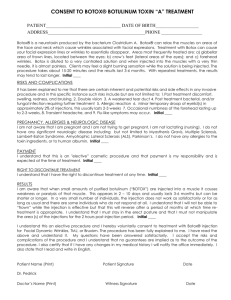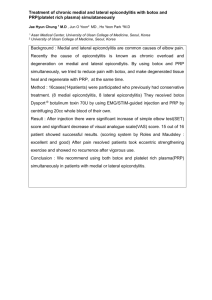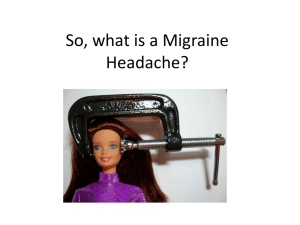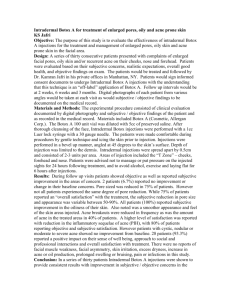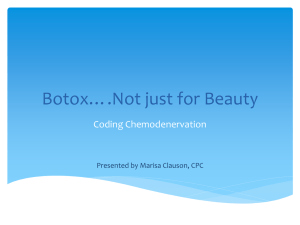Botox - UMMS Wiki
advertisement
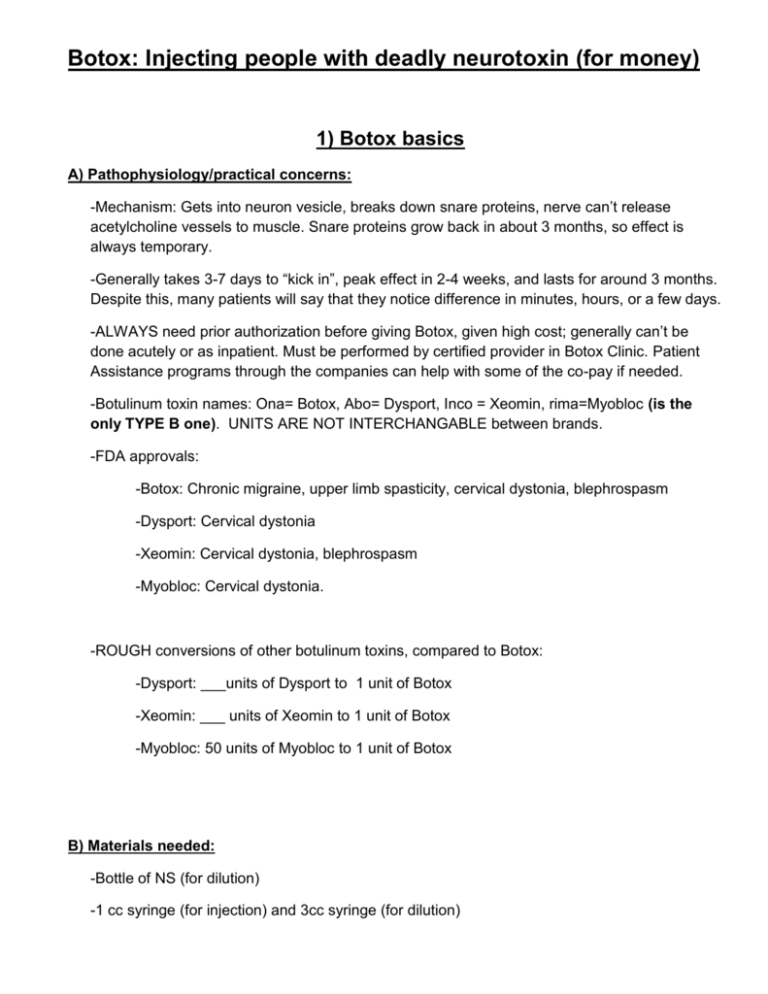
Botox: Injecting people with deadly neurotoxin (for money) 1) Botox basics A) Pathophysiology/practical concerns: -Mechanism: Gets into neuron vesicle, breaks down snare proteins, nerve can’t release acetylcholine vessels to muscle. Snare proteins grow back in about 3 months, so effect is always temporary. -Generally takes 3-7 days to “kick in”, peak effect in 2-4 weeks, and lasts for around 3 months. Despite this, many patients will say that they notice difference in minutes, hours, or a few days. -ALWAYS need prior authorization before giving Botox, given high cost; generally can’t be done acutely or as inpatient. Must be performed by certified provider in Botox Clinic. Patient Assistance programs through the companies can help with some of the co-pay if needed. -Botulinum toxin names: Ona= Botox, Abo= Dysport, Inco = Xeomin, rima=Myobloc (is the only TYPE B one). UNITS ARE NOT INTERCHANGABLE between brands. -FDA approvals: -Botox: Chronic migraine, upper limb spasticity, cervical dystonia, blephrospasm -Dysport: Cervical dystonia -Xeomin: Cervical dystonia, blephrospasm -Myobloc: Cervical dystonia. -ROUGH conversions of other botulinum toxins, compared to Botox: -Dysport: ___units of Dysport to 1 unit of Botox -Xeomin: ___ units of Xeomin to 1 unit of Botox -Myobloc: 50 units of Myobloc to 1 unit of Botox B) Materials needed: -Bottle of NS (for dilution) -1 cc syringe (for injection) and 3cc syringe (for dilution) -21 gauge (for dilution/readying botox) and 30 gauge (for face muscles) needles -Alcohol swab, tissues -Botox -Gloves -EMG/special EMG needle/grounding pads (unless injecting facial muscles) C) Diluting/preparing the botox: -KEY first step is knowing ahead of time what you will inject, and in what amounts, so you can measure out appropriate amounts in syringe to minimize pokes and wasted Botox. -Procedure for dilutions: 1) Get a 21 gauge needle on a 3cc syringe and inject air into bottle of NS. 2) Inject 1.1 cc (for 1:1 dilution) or 2.1 cc (for 2:1 dilution) of NS per 100 unit NEW Botox bottle. The extra 0.1cc is because you can’t get every last drop out. No need to swirl/shake the bottle. 3) Take a 1cc syringe with a 21 gauge needle and “Burp” the Botox bottle with open syringe to offset vacuum. Using that same syringe, slide the needle along the inside corner of the bottle and draw up what you need. Tip the syringe to 45 degree and flick syringe to get rid of air bubbles gently. 4) If botoxing the face, replace the 21 gauge needle on the 1cc syringe with a 30 cc needle, after you’ve drawn up the Botox. Protip: You can tell if a Botox bottle has been used, as unused bottles have the dry white residue visible on the bottom. D) Explaining Botox to a new patient: -Botox works by temporarily weakening specific overactive muscles. -When to use: When have involuntary muscle movements that are bothersome/limiting. -How it works: Use tiny needle (smaller than blood draw needle) with EMG attached to locate problem muscles, and inject Botox into them. Find muscles by combination of knowledge of anatomy + EMG. -Starts working in 1-7 days, effect peaks after about 1 month, wears off in 8-14 weeks. Not a permanent fix, you need to re-inject every 3 months (not sooner, as your immune system could make it stop working if use too often; possibly can wait longer). Often the early injections don’t achieve best possible effect, and we need to adjust the dose amount or location in subsequent visits for optimal results. -Risks: Pain, infection, bleeding, not work, local weakness/dysphagia. Side effects sually last 1-2 weeks. Black box warning of remote possibility of distal spread of toxin (small number of kids getting large doses in their legs got breathing/swallowing problems and died; never seen this complication ourselves, but good to have family know Heimlich maneuver). -NOT a mandatory thing, you can say no at any time. This is symptomatic benefit only. E) Record-keeping and chart documentation: ______ -Sample note: _____ F) Billing: -Under visit type, use code “99999”. -Click charge capture click injection Then click Botox A, needle EMG (if used), and procedure type within procedure type, chose the correct diagnosis, under “quantity” type the total number of units of Botox used (used + wasted), and under “modifier” type “50” if injected anything bilaterally (excluding migraine injections). -Make sure to store extra botox appropriately in the fridge; used bottles of Botox are usually good for a couple weeks. Label their dilution (1:1, 2:1, etc) and date opened. G) Trouble-shooting/notables -Dose increase needed: As general rule of thumb, if dose increase is needed, increase by about 50% of prior dose; if more dangerous/vulnerable area (SCM, hands, etc) increase by 30%. -Reasons injections not working: Wrong muscle, inadequate dose, unrealistic expectations, stress-induced exacerbation, fixed posture, “bad batch”, post-traumatic dystonia, tremor; MUCH LESS LIKELY changing of dystonia or immune resistance (1-2%). -Possible immune resistance: Inject 20 units into unilateral brow; if no resistance, will lose grimace on one side. If immune resistance develops, try different serotype of toxin. If VERY resistant, may need to consider alternative options (peripheral denervation, DBS, oral meds, etc) -Dysphagia: usually resolves in a few weeks. Advise patients to avoid meats, nuts, and (if difficult) thin liquids. Eat well-cooked foods with small pieces/small bites, and chew well without talking or getting distracted while eating. Make sure people around you know the Heimlich, and when to perform it. At next injection, alter where you inject/amount to reduce chance of recurrent dysphagia. -If injecting >50 units in one muscle, usually split up dose into a few locations along muscle. H) What to ask patients when they come back as RV: -Adequate symptom relief from last injection? If not, what was insufficient? -What pattern/amount has worked best before? Anything NOT work well before (may need to review records)? -How long before it kicked in? Before it reached max? Before it started wearing off? Before it wore off completely? -Change in the characteristics of the abnormal movement in interim? -Side effects (dysphagia, SOB, weakness, ptosis, vision changes, cosmetic concerns, etc)? 2) Conditions potentially warranting Botox A) Cervical Dystonia Background: -DDx: Cervical spine abnormality, tardive dystonia, parkinson’s plus syndrome Characteristics/exam: -Muscle hypertrophy, direction of tilt/torticollis/anterocollis/retrocollis, compensatory muscle activity, sensory trick, psychogenic aspects, symptoms beyond isolated cervical dystonia. Workup: -MRI C-spine; consider ceruloplasmin in young patient. Treatment: -Botox is gold standard Muscles involved: 1) Torticollis/head turn: -Contralateral SCM -Ipsilateral spenius capitus 2) Laterocollis/Tilt: Ipsilateral Levator scapulae Scalene Trapezius Longissimus 3) Anterocollis/head forward: -Platysma -Bilateral SCM. Generally avoid injecting for this issue, given the risks of dysphagia. 4) Retrocollis/head back: -Bilateral cervical paraspinals -Bilateral spenius capitus 5) Shoulder elevation: -Ipsilateral trap: As above -Ipsilateral Levator scapulae: As above. B) Oromandibular dystonia: Background: -Female: male 2:1. Characteristics/exam: -Can be classified as jaw opening (lateral pterygoids,digastric, suprahyoid), jaw closing (masseter, temporalis, medial pterygoids), jaw deviation, or mixed Workup: -MRI, cerumoplasmin Treatment: -Sinemet, anticholinergics, benzos, baclofen, gabapentin, botox, DBS Botox: -Muscles vary based on specific presentation. -1:1 dilution for tongue, 2:1 dilution for other facial muscles. -Genioglossal: Tongue protrusion. -Mentalis: Pulls chin down. -Masseter: Biting. -Temporalis: Biting. -Oris: Puckering. Watch out for trouble with water leaking out of mouth as side effect. -Depressor angulara oris: Frowns/pulls down face. -Lateral ptyerygoid: attaches to TMJ. Opens jaw, deviates jaw to OPPOSITE side. -Side effects: Depends on muscles injected. Can include trouble chewing/moving food in mouth, sucking straw, water leaking out mouth. Make sure people know to take small bites, have relatives know Heimlich, etc. C) Blephrospasm: Background: -Focal dystonia. -Mid 50’s, female predominance. -Idiopathic (most common) vs. symptomatic (PD, PSP, tardive, midbrain lesion) vs. apraxia of eyelid opening. Characteristics/exam: -May begin with increased blinking, can result in persistent eyelid closure. -Can involve blinking, photosensitivity, dry eyes, involuntary eye closure. -Can often elicit by having patient squeeze eyes shut and then open rapidly, repeatedly Workup: -None required if isolated presentation without other signs. Treatment: -Botox is treatment of choice -Oral med effectiveness is limited (anticholinergics, neuroleptics, benzos) vs. surgical (last resort is myectomy or DBS via GPi). Botox: -Inject in the below pattern (bilaterally), 2.5 units each at 2:1 dilution with 30 gauge needle. Avoid levator palpeprae (center of upper eyelid) to avoid ptosis; 2.5 units per site, 12.5 units per eye total. Can also consider adding additional sites over each brow (total of 3 sites per brow) at 5 units each, and if not work then increase to 10 units at each brow site. -93% success rate. -Adverse effects: ptosis (20%), dry eyes (6%). D) Hemifacial spasm: Background: -Segmental myoclonus, NOT dystonia. -Involuntary contraction of unilateral 7th CN muscles. -Usually idiopathic vs. vascular loop compressing unilateral CN VII or structural lesion -Female predominance. -DDx post-Bell’s synkinesias (treated the same way), tics, tardive spasms, myokymia Characteristics/exam: - Often see tonically raised eyebrow; specific sign is eyebrow raise when eye shuts. Often mistaken for facial tic; difference is no urge to perform movement, and obviously involuntary. Often starts around eye, and eventually (and unpredictably) involves muscle of lower face too. Workup: -CN 7 protocol MRI brain w/ and w/o contrast looking for structural lesion (ie, tumor) abutting nerve; no need for MRA, as vascular decompression is last resort and almost never needed. Treatment: -Botox; consider vascular loop decompression only as absolute last resort. Botox: -2:1 dilution, 2.5 units per injection (0.05ml per injection), total 17.5 units of Botox. If inadequate, can escalate to 3 or 3.5 units per injection (0.06 ml, total 21 units). May also need to add injections to muscles in lower face over time. -First time, inject upper face only; if lower face twitches, next time add SMALL amounts to lower face muscles mentalis/platysma > risorius/depressor anguli; anything higher than the lip is more liable to cause weakness/symmetry issues. -Injecting Eye: Inject glabella, medial above eyebrow, lateral upper lid (superficial), lateral canthus, inferolateral lower lid (between cheek and eye, superficial), centro-lateral lower lid (between cheek and eye), medial upper lid (superficial). -Injecting Lower face (dependent on pattern): lower twitching is mentalis, platysma >risorius and depressor anguli (2 units each); upper twitching is zygomaticus. -Avoid central upper lid or medial lower lid, to avoid ptosis and eye movement abnormalities (respectively) -Side effects: facial weakness, vision changes, ptosis. E) Migraines: Background: -To get insurance approval, document chronic medically refractory migraine that has failed/couldn’t tolerate reasonable trials of 3 good headache prophylactics (beta blocker, Topamax, and a TCA are good first choices), and with headaches present at least 15 days per month. Characteristics/exam: -Migrainous headaches; rule out neurologic abnormalities or specific headache syndromes that may respond better to other therapies (hemicranias, cervicogenic, occipital neuralgia, trigeminal neuralgia, pseudotumor, GCA, etc) -Need to document that they tried and failed adequate trials of 3 first-line oral meds (TCAs, beta-blockers, calcium channel blockers, anti-epileptics), and that they have >= 15 days of migrainous headache per month. Workup: -None needed if typical migraines Botox: -Initial requirements for approval: Failed reasonable trials of three first-line classes of headache prophylactics (TCAs, beta blockers, calcium channel blockers, SNRIs, anti-epileptics), 15 or more headache days per month. -After 4 treatments, need to have at least 7 additional headache-free days per month, OR at least 100 additional headache-free hours a month to get additional treatments approved. -155 units of 1:1 dilution in STANDARD distribution (see diagram below) using 30cc needle, 5 units (0.05cc) per location directly subcutaneously; if not respond after first trial, increase to max of 200 units “following the pain” with 7.5 units in half the spots, and 5 units in the other half. -Have them bite to bring out temporalis, and trace as a line a couple finger breadths above line a pair of glasses would take; do occipitalis directly below where bone slopes off, in a triangle pattern or line. Don’t go too low with cervical paraspinals. -If fails 2 trials of 200 units, likely Botox non-responder and should no longer receive Botox -Bill with diagnosis code 346.71 -20% get no response on first dose. ->50% of patients responded after 3 cycles. By cycle 2, 50% had >50% decrease in # of headache days. By Cycle 5, 2/3 of patients were responders and had >50% decrease in headache days, cumulative headache hours, and and severity) -4% get mild head heaviness 2/2 neck injection portion. F) Limb Dystonias: 1) Arm -As a rule, flexors/pronators are “safer” to inject than extensors/supinators; side effects include trouble opening jars, writing, opening doors, throwing ball, using utensils. -Flexors live in medial anterior forearm, extensors in lateral anterior forearm. -For Writer’s Cramp, watch them write, and ALSO have them write with off-hand to bring out the dystonia (“mirror sign”). G) Sialorrhea: Background: -DDx neuromuscular/sensory dysfunction, hypersecretion, anatomic. Workup: -None Treatment: -Trial glycopyyrolate, scoplamine, atropine drops, botox. Botox: -Parotid gland (2 finger breadths anterior to ear, and 2 finger breadths down from bottom of ear line) -submandibular gland (1/3 of way from angle of jaw to chin, and directly below mandible, angling up) -Dosing: Myoblock: 1000 units parotids, 250 units submandibular gland; Botox: 30 units parotids, 10 units submandibular H) Spasmodic dysphonia: Background: -Described in 1871, initially felt to be psychiatric -1/100,000 mainly females age 40-50’s -Voice disorder that is task induced with spasms of laryngeal musculature Characteristics/exam: -Strained, strangled, breathiness, pitch breaks. Workup: -ENT referral for diagnosis. Treatment: -Referral to otolaryngologist with botox experience, voice therapy, or surgery. Botox usually handled by ENT. Botox: -Adductor: Inject 5mm left or right of space between two thyroid cartilages. Dose 2-2.5 units -Abductor: Push it in DEEP to same area. 3 units. 3) Summary of muscles and their injection sites: Muscle Action Location to inject Facial muscles Starting Botox dose Rough upper limit Genioglossus Protrude tongue Depressor Anguli Mentalis Risorias Frown Pulls chin down Fake smile Zygomaticus Masseter Real smile Bite down Temporalis Bite down Oris Lateral Pterygoid Puckers lips Opens jaw, deviates to opposite side Pulls down mouth Platysma SCM Spenius capitis Levator Scapulae Scalene Cervical paraspinals Trapezius Longissmus Flexior Digitorum Profundus (FDP) Flexor Digitorum Superficialis (FDS) Flexor Pollicis Longus (FPL) Flexor Carpi Radialis (FCR) Pronator Teres (PT) Flexor Carpi Ulnaris (FCU) Opponens Pollicis Tilt head back, inject 1 cm lateral from midline and 1 cm below chin, straight up; protrude tongue to confirm location on EMG Follow nasolabial fold down to jaw Anterior chin Lateral to mouth and slightly below midline Inferior to cheek Between ear and cheek 6 each side 3 3 2 2 15, divided in 3-4 spots At temples, start at hairline and work posteriorly. From top of ear, diagonally toward vertex (like a thick ruler in width), in a diamond pattern Neck muscles Turn head contralateral; Side of neck; place hand on opposite anterocollis cheek and turn into it to bring out Turn/tilt head Behind and below ear, a divot at hair ipsilaterally, retrocollis line (bilateral) Tilt head ipsilaterally, Neck: Directly below splenius capitus, shoulder elevation at neck line, anterior to trap. Back: Find medial border of scapula, and go ½ distance from there to base of neck (raise shoulder to bring out) Tilt head ipsilaterally Behind and inferior to SCM, in “soft triangle” Retrocollis Lateral to spine Shrug shoulder Where shoulder meets neck; shrug shoulder to elicit. Find trap in neck, pull it back and inject just anterior to it. Hand/arm muscles Flexes distal finger joint Bend arm; find ulna on medial edge of arm roughly 1/3 of way from elbow; inject directly anterior to ulna, and deep Flexes proximal finger Arm flat on table. 1/3 of way from joints elbow, just medial of midline. Flex fingers against resistance to locate. Superficial. Flex thumb Inject dead center of anterior arm, aiming radially. Go deep until hit radius, then pull back slightly and inject. Flex wrist radially On anterior arm near elbow crease, find anterior (triangle) fossa, just medial and distal to it; superficial Pronate wrist On anterior arm near elbow crease, find anterior (triangle) fossa, and inject just medial to it Flex wrist radially Bend arm; find ulna on medial edge of arm roughly 1/3 of way from elbow; inject directly anterior to ulna, superficial Thumb to pinky Anterior thumb, mid-metacarpal, just lateral to bone 1-2 5 per side, in 2-3 sites 30-40 30-50 100 30 100 20 100 30-50 30-45 100 130-150 12 60 20 divided in 2 sites 60 5 20 10-20 60 10-20 30 60 10 Pronator Quadratus Pronate forearm Extensor carpi radialis Extend wrist radially Extensor Carpi Ulnaris Extend wrist ulnar Extensor Digiti communis Extend fingers Adductor Pollicis Adduct thumb Flex wrist, come in dead on into medial wrist from the side just anterior to ulnar bone, angle straight on 1/3 down dorsal arm, IN THE ACTUAL MOVABLE MUSCLE, medial part of it Bend arm, 1/3 up arm, find ulna, just dorsal to that and superficial 1/3 of the way down the dorsal arm, lateral side, medial TO the movable muscle mass (not in the mass) On posterior side, inject directly into web space between thumb and index finger, angling toward thumb 20 20 20 2.5 10 20 80 Lower extremity muscles Anterior Tibialis Dorsiflex foot ¼- 1/5 down anterior leg,slightly lateral
